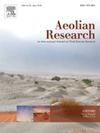加强风蚀危害评估:结合综合土地风蚀易感性(ILSWE)指数和机器学习算法的新框架(以伊朗东南部Saravan地区为例)
IF 3.4
3区 地球科学
Q2 GEOGRAPHY, PHYSICAL
引用次数: 0
摘要
风蚀对全球干旱和半干旱生态系统构成重大威胁,特别是在中东,这是尘埃排放的主要来源。伊朗拥有广阔的干旱和半干旱景观,风蚀对经济和生态造成了巨大的破坏,每年造成的损失超过180亿美元。本研究开发了一种新的方法,用于绘制伊朗东南部Saravan县的风蚀危害地图,解决了对准确危害评估和有针对性缓解战略的迫切需求。利用综合土地风蚀敏感性(ILSWE)模型,结合气候侵蚀力、土壤可蚀性、土壤结壳、植被覆盖和地表粗糙度等各种因素,创建了初始的风蚀盘存图。然后使用该清单来训练和验证三种机器学习(ML)模型(Bagged CART, Random Forest和XGBoost)。采用受试者工作特征(ROC)曲线分析评估模型的性能,随机森林模型的准确率最高(AUC = 0.95)。结果表明:42.7%的研究区为风蚀高发区或极高发区,主要分布在萨拉万西部,以草地退化、植被稀疏为特征;影响风蚀危害的关键因素包括海拔高度、粘土含量和碳酸钙含量。这项研究证明了将ILSWE模型与ML技术结合起来精确绘制风蚀危害的有效性,为确定缓解工作的优先顺序和促进干旱和半干旱环境中的可持续土地管理实践提供了有价值的信息。所开发的方法为全球其他脆弱地区的风蚀评估提供了一个可转移的框架。本文章由计算机程序翻译,如有差异,请以英文原文为准。
Enhancing wind erosion hazard assessment: a novel framework combining integrated land susceptibility to wind erosion (ILSWE) index and machine learning algorithms (case study: Saravan area, Southeast Iran)
Wind erosion poses a significant threat to arid and semi-arid ecosystems globally, particularly in the Middle East, a major source of dust emissions. Iran, with extensive arid and semi-arid landscapes, experiences substantial economic and ecological damage from wind erosion, exceeding US$18 billion annually. This study developed a novel methodology for mapping wind erosion hazard in Saravan County, southeast Iran, addressing the critical need for accurate hazard assessment and targeted mitigation strategies. An initial wind erosion inventory map was created using the Integrated Land Susceptibility to Wind Erosion (ILSWE) model, incorporating various factors like climatic erosivity, soil erodibility, soil crust, vegetation cover, and surface roughness. This inventory was then used to train and validate three machine learning (ML) models (Bagged CART, Random Forest, and XGBoost). Model performance was evaluated using Receiver Operating Characteristic (ROC) curve analysis, with the Random Forest model achieving the highest accuracy (AUC = 0.95). Results indicated that 42.7 % of the study area is classified at high or very high hazard for wind erosion, primarily located in western Saravan, characterized by degraded rangelands with sparse vegetation. Key factors influencing wind erosion hazard included elevation, clay content, and calcium carbonate content. This research demonstrates the efficacy of integrating the ILSWE model with ML techniques for accurate mapping of wind erosion hazard, providing valuable information for prioritizing mitigation efforts and promoting sustainable land management practices in arid and semi-arid environments. The developed methodology offers a transferable framework for wind erosion assessment in other vulnerable regions worldwide.
求助全文
通过发布文献求助,成功后即可免费获取论文全文。
去求助
来源期刊

Aeolian Research
GEOGRAPHY, PHYSICAL-
CiteScore
7.10
自引率
6.10%
发文量
43
审稿时长
>12 weeks
期刊介绍:
The scope of Aeolian Research includes the following topics:
• Fundamental Aeolian processes, including sand and dust entrainment, transport and deposition of sediment
• Modeling and field studies of Aeolian processes
• Instrumentation/measurement in the field and lab
• Practical applications including environmental impacts and erosion control
• Aeolian landforms, geomorphology and paleoenvironments
• Dust-atmosphere/cloud interactions.
 求助内容:
求助内容: 应助结果提醒方式:
应助结果提醒方式:


